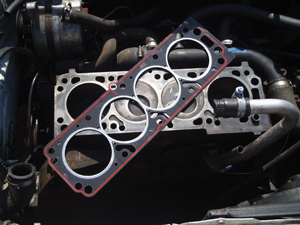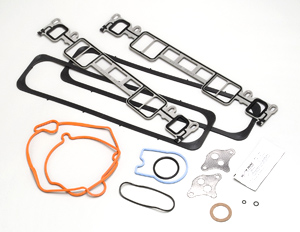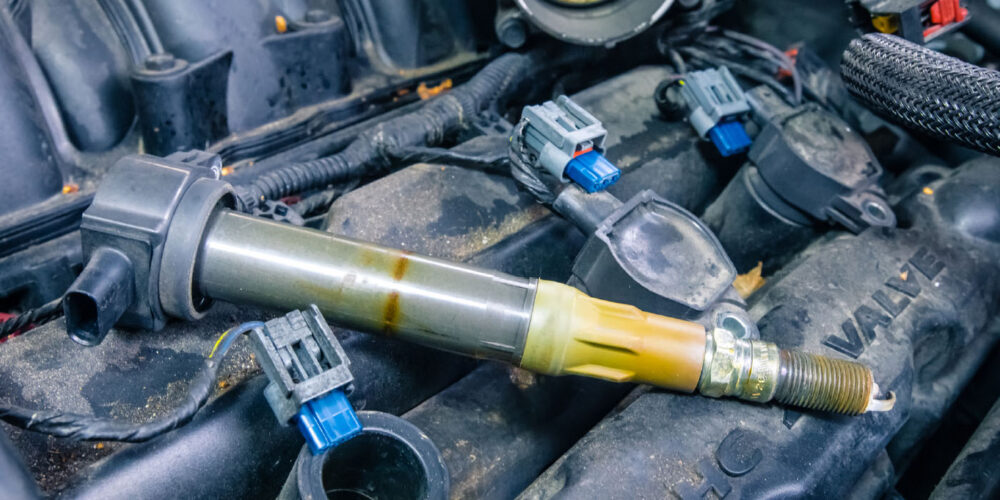By Brendan Baker
Senior Editor
ENGINE BUILDER Magazine
Since the days of sealing engines with asbestos, cork, rope and paper are, for the most part, ancient history, new-age materials and designs have elevated the critical role gaskets and seals play in the longevity of an engine. Finding the optimum sealing material and design remain a challenge many gasket manufacturers face as engines are asked to do more.
Gaskets that combine high performance polymers with metal or fiber substrates are being used in more and more engine applications. Furthermore, engines that are sealed using these higher quality gaskets are lasting longer, performing better and with less maintenance or chance of the dreaded warranty comeback claim.
 There are many considerations engine builders must take into account when selecting the best gaskets for an application. With engines having higher performance requirements, stricter emission regulations, and tighter design tolerances along with production cost considerations and quality standards that are increasing, the last thing any engine builder wants to worry about is a gasket or seal failure. It doesn’t matter if you’re building a Pro Stock or stock production engine the risks are simply too great to use a subpar gasket or seal.
There are many considerations engine builders must take into account when selecting the best gaskets for an application. With engines having higher performance requirements, stricter emission regulations, and tighter design tolerances along with production cost considerations and quality standards that are increasing, the last thing any engine builder wants to worry about is a gasket or seal failure. It doesn’t matter if you’re building a Pro Stock or stock production engine the risks are simply too great to use a subpar gasket or seal.
It’s more complicated to seal today’s engines because depending on the application, modern engines are expected to last well over 150,000 miles without fail. Performance engines are pumping out more power than ever. So keeping these engines sealed can be a tall order and creates a hefty job for engine gaskets and seals to handle.
Engine seals and gaskets are supposed to prevent the leakage of oil, coolant and air between mating surfaces, internal passages and the outside of the engine. Seals and gaskets also prevent the entry of dirt and air into the engine.
Modern Science,
Modern Material
Gasket manufacturers use all kinds of materials and designs to keep engine oil, coolant, vacuum and compression separated from each other. Through the use of computer aided design (CAD), finite element analysis (FEA) and polymer science, gasket engineers can now more thoroughly understand many facets of the joint they are trying to seal and are able to design a gasket with materials that will withstand the pressures of the environment. Materials such as Teflon, Viton, Graphite and other specialized materials are taking the place of older, less compatible and less durable materials. The following list shows the types of materials used in automotive applications and the characteristics of each type.
Viton
Viton is a registered trademark of DuPont Performance Elastomers and is commonly called Fluoroelastomer/Viton (FPM). It is best known for its ability to tolerate high temperature environments (400°F), which makes it well suited for automotive applications. Viton can also easily withstand aggressive fuels and chemicals and has excellent mechanical properties as well. This material is also resistant to abrasion and cuts. With a broad array of applications in the automotive, chemical processing and industrial markets, Viton fits many performance specifications.
Neoprene Polychloroprene
Neoprene polychloroprene was the first synthetic elastomer able to resist oil and is still a popular material in a number of automotive applications. Neoprene remains a popular choice for many automotive applications that require a reasonably priced, mid-performance polymer with a good all-around balance of performance properties.
Nitrile (NBR)
NBR provides excellent resistance to petroleum oils and gasoline as well as mineral and vegetable oils. However, NBR has poor resistance to the swelling action of oxygenated solvents such as acetone and ketones. It has good resistance to acids and bases except those having strong oxidizing effects. Resistance to heat aging is good, which is a key advantage over natural rubber.
Higher acrylonitrile contents increase solvent resistance but decrease low-temperature flexibility, and compounding this material to improve low-temperature flexibility decreases oil and solvent resistance. This material does not crystallize on stretching and reinforcing materials are required to obtain high strength. With compounding, it is possible to get a good balance between low creep, good resilience, low permanent set and good abrasion resistance. Tear resistance and electrical insulation properties of NBR are inferior to natural rubber.
Silicone Rubber
Silicone rubber offers stability over a wide temperature range, resistance to harsh environments, and long lasting performance exceeding many organic elastomers. Silicone rubber offers incredible resistance to extreme temperatures, being able to operate normally from minus 100°C to plus 250°C (212° to 482° F). When compared to natural rubbers, silicone has better fire resistant properties and is an excellent electrical insulator. Thermal stability means that properties such as volume resistivity, dielectric strength and power factor are not affected by changes in temperature
Head Gasket Evolution The cylinder head gasket is arguably the most important seal in the engine. Since the very first internal combustion engines were produced, gasket designers have specified many materials to meet this difficult sealing challenge.
The cylinder head gasket is arguably the most important seal in the engine. Since the very first internal combustion engines were produced, gasket designers have specified many materials to meet this difficult sealing challenge.
Copper and brass gaskets were some of the earliest materials used but gave way to metal and asbestos composite gaskets in the 1950s, superseded in turn by composite metal and impregnated fiber or graphite composites by the 1980s. However, those systems were largely overtaken by the development of the Multi-Layer Steel (MLS) gasket in Japan during the early 1990s.
MLS gaskets remain the automotive industry’s preferred method of sealing the cylinder head and block, and is unmatched by any other sealing system to this point. Today, it is roughly estimated that 80 percent of new engines are designed with MLS gaskets as standard equipment and further growth is projected.
In the MLS gasket, multiple thin layers of cold-rolled spring grade stainless steel are coated with 7-25 microns of elastomeric material. The resilient elastomer is essential to the structure by providing micro-sealing of metal surface imperfections while resisting aggressive combustion gases, oils and coolants at temperatures up to 250°C or 480° F.
Fluoroelastomer (FKM) has been utilized by much of the European OEs and is the most successful coating material for long-term functionality critical sealing environments such as automotive engines. Although nitrile rubber (NBR) has been widely used for MLS coatings in the U.S. and Japan, the use of FKM is expected to grow rapidly among the OEs in both of these markets in next few years.
Head Gasket Failures
With most OEMs choosing to use aluminum rather than iron cylinder heads, the chance of a head gasket failure is increased, Even though aluminum is lighter than iron, it has a much greater thermal expansion rate, which in turn creates more stress on the head gasket. Engine manufacturers have responded to this by adding a non-stick coating such as Teflon or some other type of slick coating to the surface of the head gasket.
Most engine builders know that when a head gasket fails, a whole range of problems can occur, from compression loss to exhaust gases being forced into the cooling system, leading to the engine overheating and increased engine wear due to the oil being mixed with antifreeze. Coolant can leak into the cylinders, causing the exhaust to blow off steam and the steamy coolant mixture can damage the catalytic converter. If a very large amount of coolant does this, hydrolock can occur, causing extensive engine damage. Sometimes, all that may happen when a head gasket is blown is an eruption of steam from the tailpipe, though the engine may act and drive like normal.
If your customer supects a blown head gasket you or your intaller can investigate the situation by checking the compression with a pressure gauge, but the preferable method is a leak-down test, noting any indication of combustion gasses in the cooling system. Oil mixed with coolant and excessive coolant loss with no apparent cause, or presence of carbon monoxide or hydrocarbon gases in the expansion tank of the cooling system can also be signs of head gasket problems.
Intake Manifold Gaskets
The head casting-to-intake manifold joint is critical because if you experience a failure it will create a vacuum leak which will in turn create a poor running engine and an unhappy customer. It is recommended that you check the head and manifold sealing surfaces with a straightedge and machine them flat if any warpage is found. As with the head/block seam, premium gaskets of graphite or with synthetic faces and perhaps a printed-on bead are commonly available, and usually no retorquing is needed.
Another relatively new type of manifold gasket has a metal or plastic carrier with rubber inserts or deposited rubber beads. You have to try pretty hard to make a mistake while installing these gaskets because the carrier acts as a positive stop so the rubber cannot be over compressed. These gaskets don’t require any sealant either. Also, V8 and V6 engines that have tabs or endstrips on the manifold gaskets should be handled carefully. The tabs are easy to dislodge while you’re lowering the manifold into place. You can use a light coat of adhesive if you want to try and keep them in place.
Intake manifold bolts should be tightened in a pattern similar to the sequence used to torque the cylinder head down. The goal here is to work from the center outward unless manufacturer specifications say otherwise. Do not over-torque these bolts. Not only will this save you from the disaster of a snapped bolt, but on some applications it can prevent a head gasket failure. The pressure from the weight of the manifold can push the heads outward enough to reduce clamping force that could lead to a blown head gasket.
Valve Cover and Pan Gaskets
The most basic type of gasket is the cut gasket, which are made by die-cutting sheets of fiber-reinforced paper-like material or ground cork/rubber to create the flange shape of the cover. Cut gaskets are most often used in timing covers, valve covers, oil pans, intake manifolds, carburetors, throttle bodies, water pumps, thermostat housings, etc. Cut gaskets are also the least expensive to make and allow the OEMs to use stamped steel valve covers, timing covers and oil pans instead of more costly cast aluminum.
Older style cork/rubber gaskets don’t last forever and have a tendency to leak, which is why most of these gaskets are no longer used by OEMs. Most manufacturers use molded rubber or plastic carrier gaskets for these applications. The plastic carrier gasket is much more durable and can last as long as the engine without failure.
Over-tightening these gaskets will often crush or crack the gasket, which then leads to a failure down the road. Some pan and cover gaskets have extra features that allow them to be installed more easily than standard cork/rubber gaskets. Features include grommets for lining up the holes and metal carriers to make the gasket stiffer so it won’t flop all over when you try to line everything up.
In order for pan and cover gaskets to seal properly the surfaces must be clean, dry and as flat as possible, free from nicks and burrs that might catch or tear the gasket material. The surface must also be free of any old gasket residue, which should be completely removed during the cleaning process.
Trends in oil pan sealing are toward metal grommets being inserted into the boltholes or shouldered fasteners to guard against over-torquing, and one-piece rubber gaskets. For timing chain covers, thermostat housings, etc, a thin paper-type gasket is often used in these applications. These require that you apply a thin bead of a good sealant and follow a careful torquing procedure.
Valve Stem Seals
Valve stem seals control the lubrication of the valve stem as it slides in the valve guide. Too little oil contributes to stem and guide wear. Too much oil increases oil consumption and can cause a buildup of carbon, leading to valve seat damage and early valve failure, as well as loss of engine performance and emission failures.














